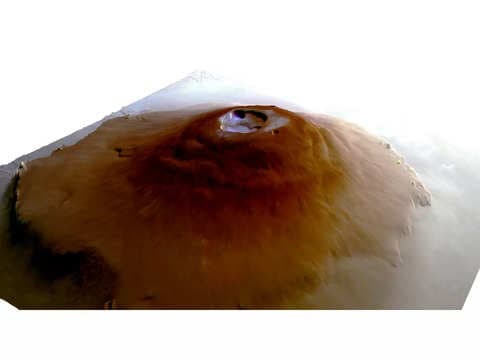But on
Against all odds, scientists have detected water frost at Mars' equator for the first time ever! Even more astonishing, this discovery occurred in a Martian region where frost was once thought to be an impossibility.
The frosty revelations come from observations of the Tharsis region on Mars, which includes some of the solar system's tallest volcanoes: Olympus Mons, Arsia Mons, Ascraeus Mons and Ceraunius Tholus. Here, deposits of transient morning frost were detected on the volcanoes' summits, regions previously assumed to be too warm for frost to form.
This breakthrough began with the detection of lighter, bluish areas on the volcanoes' peaks by the Colour and Stereo Surface Imaging System (CaSSIS) on ESA’s ExoMars Trace Gas Orbiter (TGO). Initially puzzling, these light patches appeared consistently only in early morning observations during Mars' cold seasons.
Further investigation confirmed that these lighter areas were indeed water frost, as the High-Resolution Stereo Camera (HRSC) on ESA's Mars Express also recorded these features. Yet, the origin of this phenomenon remained elusive until researchers conducted numerical simulations to replicate the microclimate of Mars' volcanoes.
These simulations, similar to those used in predicting Earth’s weather but tailored for Martian conditions, revealed that the clear zones corresponded with conditions suitable for water condensation. They confirmed that these icy patches were the result of frost forming overnight under the right climatic conditions on Mars.
The simulations also showed that surface temperatures on these Martian volcanoes are conducive to the existence of frozen water. However, the intense solar exposure at the equator causes the frost to dissipate rapidly each morning, explaining its transient nature.
The frost layer itself is extraordinarily thin, just 10 micrometres thick, reflecting Mars' limited atmospheric water vapour. In terms of volume, the frost could cover about 60 Olympic-sized swimming pools if harvested. Though this seems substantial, it's a minuscule quantity compared to Mars’ total surface area. Nonetheless, it represents a potential resource for future astronauts, who could use it for drinking water or converting it into rocket fuel.
This discovery not only enhances our understanding of Mars' current water cycle, but also offers clues about its past climate and potential habitability. By refining our knowledge of Martian weather patterns, we can better prepare for future exploration and continue unravelling the mysteries of the Red Planet.
These findings were recently published in the journal Nature Geoscience and can be accessed here.
